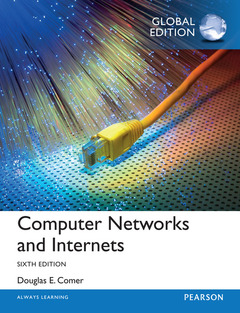Description
Computer Networks and Internets, Global Edition (6th Ed.)
Author: Comer Douglas
Language: English
672 p. · 17.9x23.5 cm · Paperback
Description
/li>Contents
/li>Comment
/li>
Appropriate for all introductory-to-intermediate courses in computer networking, the Internet, or Internet applications; students need no background in networking, operating systems, or advanced mathematics.
Leading networking authority Douglas Comer presents a wide-ranging, self-contained tour of the concepts, principles, and technologies that enable today?s Internet to support applications ranging from web browsing to telephony and multimedia. Comer begins by illuminating the applications and facilities offered by today?s Internet. Next, he systematically introduces the underlying network technologies and protocols that make them possible. With these concepts and technologies established, he introduces several of the most important contemporary issues faced by network implementers and managers, including quality of service, Internet telephony, multimedia, network security, and network management. Comer has carefully designed this book to support both top-down and bottom-up teaching approaches. Students need no background in operating systems, and no sophisticated math: Comer relies throughout on figures, drawings, examples, and analogies, not mathematical proofs.
- Chapter 1 Introduction And Overview
- Chapter 2 Internet Trends
- Chapter 3 Internet Applications And Network Programming
- Chapter 4 Traditional Internet Applications
- Chapter 5 Overview Of Data Communications
- Chapter 6 Information Sources And Signals
- Chapter 7 Transmission Media
- Chapter 8 Reliability And Channel Coding
- Chapter 9 Transmission Modes
- Chapter 10 Modulation And Modems
- Chapter 11 Multiplexing And Demultiplexing (Channelization)
- Chapter 12 Access And Interconnection Technologies
- Chapter 13 Local Area Networks: Packets, Frames, And Topologies
- Chapter 14 The IEEE MAC Sublayer
- Chapter 15 Wired LAN Technology (Ethernet And 802.3)
- Chapter 16 Wireless Networking Technologies
- Chapter 17 Repeaters, Bridges, And Switches
- Chapter 18 WAN Technologies And Dynamic Routing
- Chapter 19 Networking Technologies Past And Present
- Chapter 20 Internetworking: Concepts, Architecture, And Protocols
- Chapter 21 IP: Internet Addressing
- Chapter 22 Datagram Forwarding
- Chapter 23 Support Protocols And Technologies
- Chapter 24 UDP: Datagram Transport Service
- Chapter 25 TCP: Reliable Transport Service
- Chapter 26 Internet Routing And Routing Protocols
- Chapter 27 Network Performance (QoS And DiffServ)
- Chapter 28 Multimedia And IP Telephony (VoIP)
- Chapter 29 Network Security
- Chapter 30 Network Management (SNMP)
- Chapter 31 Software Defined Networking (SDN)
- Chapter 32 The Internet Of Things
- Chapter 33 Trends In Networking Technologies And Uses
- Appendix 1 A Simplified Application Programming Interface
Broad Coverage of Key Concepts and Principles, Presented in a Technology-independent Fashion
- Drawing on more than 30 years’ experience at the leading edge of networking research and implementation, Comer focuses on imparting knowledge that students will need regardless of which technologies emerge or become obsolete.
- Every chapter includes hands-on exercises and projects that offer opportunities for students to test their knowledge and gain confidence in their abilities.
Flexible Organisation that Supports both Top-down and Bottom-up Teaching Approaches
- The text is organised into five parts. Chapters may be sequenced in multiple orders to accommodate a wide variety of instructor/student/course needs and preferences.
- This text combines the best of top-down and bottom-up approaches. When presented in order, the book exposes students to applications and allows them to write network programs early, while delivering all material in logical order so a reader understands how each new technology builds on lower layer technologies.
An Accessible Presentation that Resonates with Students
- No sophisticated mathematics is required—instead of formal mathematical proofs, Comer presents highly accessible examples, figures, drawings, and analogies.
- The text answers the basic question: how do computer networks and Internets operate? It provides a comprehensive, self-contained tour through all of networking that describes applications, Internet protocols, network technologies, such as LANs and WANs, and low-level details, such as data transmission and wiring. It shows how protocols use the underlying hardware and how applications use the protocol stack to provide functionality for users.
Keep Your Course Current
In response to suggestions from readers and recent changes in networking, the new edition has been comple




